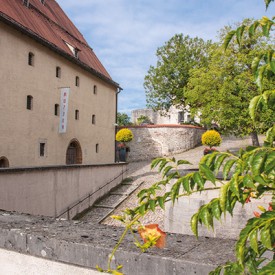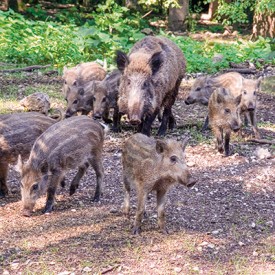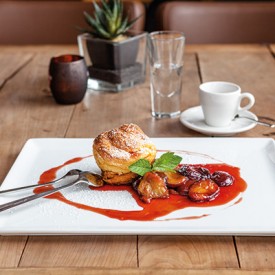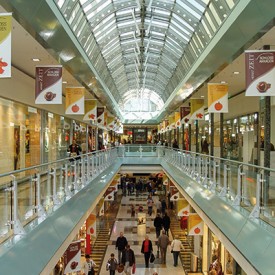Heidenheim is situated on the river Brenz on the eastern edge of the Schwäbische Alb (Swabian Alp). The medium-sized town is comprised of Heidenheim and five other villages named Schnaitheim, Mergelstetten, Oggenhausen and Großkuchen as well as Kleinkuchen – and has today a population of about 46,000.
As well as being the administrative centre, it is also the educational centre for the whole region: it offers a wide spectrum from high schools to vocational schools to a cooperative state university; it is also the domicile of global companies such as Voith and Hartmann; it is a cultural town offering an opera festival, an open-air theatre and many museums; it is home to a variety of sports – football, baseball, a city run and fencing (European Cup), impresses with a new architectually significant hotel and congress complex on the castle hill, and last but not least, it is ideal for shopping with an attractive town centre.
Find out for yourself the history of Heidenheim on the following pages, take a walk through Castle Hellenstein and the pleasant town centre, get to know the wide range of cultural and sporting events and discover all the things you can enjoy during your visit.

Heidenheim – past and present
That people lived in the Brenz valley 80,000 years ago was proven when stone tools and animal bones were found in the Heidenschmiede (forge) below the castle. Evidence of first permanent settlements has been found dating back to approximately 1300 BC. Bohnerz (brown iron ore) which was to play an important role in the later development of Heidenheim, led to the first Celtic settlements between 800 and 500 BC.
About 100 AD the Romans settled here and built a stone fort and dwelling houses. Remains of this complex, which was called Aquilea, have been found during many building projects in the centre and can be seen in the Römerbad (Roman baths) museum.
After the Alemanns had taken over Roman areas around 260 AD, the Roman epoch ended and events in the following centuries remain uncertain.
The next documented entry is dated in the 8th century. An important impulse for the further development of Heidenheim was the building of the castle, the first sections of which were erected in the 12th century. Safeguarded by the castle, the town wall was built around the settlement below the castle hill between 1190 and 1420. At that time Heidenheim consisted mainly of two streets; the front street, today’s Hauptstraße (main street), and the Hintere Gasse (back lane). In 1356 Emperor Karl IV awarded market rights to Heidenheim.
The ownership of the Castle often changed in the following centuries and with it the control of the town: from the family of Helfenstein to Württemberg, then to Bavaria and back again to Württemberg and to Ulm. However, since 1536 Heidenheim has remained a possession of Württemberg. In 1618 there were about 1,000 inhabitants in Heidenheim, after the “Thirty Years’ War” only half were left. The population increased slowly again and Heidenheim became the centre for the local and regional wandering shepherds.
A big upturn for Heidenheim followed with industrialisation around the year 1800. Textile factories, using flax grown in the area, sprung up along the River Brenz, followed by metal manufacturing companies. The opening of the railway to Aalen in 1864 helped boost the development of the region. In 1910 the northern suburb of Schnaitheim was incorporated into Heidenheim, and the Suburb Mergelstetten, south of Heidenheim, in 1931.
The town survived World War II almost undamaged. The arrival of displaced persons led to a rapid increase in Heidenheim’s population and to a building boom in the 1950’s and 1960’s.
In the years up to 1980 numerous new public facilities and institutions were build such as the Waldbad (open-air swimming pool), the Werkgymnasium (high school), the new Town Hall and the hospital on the castle hill. In 1997 an exit from the A 7 was built, linking Heidenheim directly to the German Autobahn network.
The years after 2000 have been characterized by large redevelopments in the town centre: the opening of the shopping centre SchlossArkaden and the Landesgartenschau (state garden show) in 2006, as well as the enhancement of numerous residential Areas within the framework of the Soziale Stadt (social town).
Castle Hellenstein – Staufer Heritage
No matter where you Approach Heidenheim from, the Castle Hellenstein on its 70-metre high rock catches the eye of every visitor. A tour of the castle usually starts from the South Gate. From here, looking to the left, you see the remains of the Staufer Castle with the round tower. It was erected in 1120 and is the centre of today’s complex. Parts of the western section, the so-called Upper Castle, were taken down at the beginning of the 19th century and the complete demolition could only be stopped in the last minute. Each summer the open-air stage in the former Knights’ Hall is the venue for the open-air Opera Festival.
Walking through the South Gate, you come to the Fruchtkasten (storehouse), a three-storey building erected in 1470-1471, where the natural produce, paid in kind by Heidenheim’s citizens, were stored and which today is the museum for coaches, carriages and carts.
Above the Fruchtkasten is the Brunnengärtle (garden with a well) with the 78-metre-deep Kindlesbrunnen, a well which was dug in 1666, after the existing watersupply was destroyed in the “Thirty Years’ War”.
In 1530 a fire almost completely gutted the castle complex. Under Duke Friedrich I of Württemberg, the castle was brought back to ist former glory between 1595 and 1611. The long building in the North housing the Castle Church, the present museum of local history, and the Burg and Obervogtei (administrative offices), as well as the big stronghold with its gun turrets, originate from this time.
Exploring the town centre
Our short tour (you will find it on the detailed plan on page 24) starts in the Hauptstraße (main street) at the Old Town Hall, which was completed in 1846. It housed the town’s administration offices until 1972 and is today the home of the public library, the adult education centre and the tourist information Office. Seasonal melodies chime three times a day from the Glockenspiel high up on the building.
In front of the building is a fountain called the Knöpfleswäscherin (a woman who washes dumplings). The fountain represents an anecdote that says: A woman wanted to bring her husband his lunch. Unfortunately the Knöpfle (swabian dumplings) fell out of her basket and, as she was very thrifty, she washed them in the stream and put them back into the basket and then served them to her husband.
From the fountain you proceed through a narrow lane to the New Town Hall that was completed in 1972. Looking up at the town hall you can see the “Piercing Ring,” which was created during the Sculptor Symposion in 2001.
The 75-metre-high, red church tower of St. Paul’s church, built in neo-Gothic style, rises directly behind the town hall. It is the largest protestant church in Heidenheim and was opened in 1898.
Going back now to the Grabenstraße (the street in front of the new Town Hall) and walking South you will notice the Türmle (a small half-timbered tower). This Tower was integrated into the already existing townwall in 1400. Here you will find some remaining parts of the wall.
After walking some metres South, the Pfluggasse turns right towards the main street. There you can see a limestone marking on the ground indicating the location of the former Middle Town Gate which was taken down in 1780 and replaced by an archway. Walking towards the castle, you will notice an imposing house on the corner, which has been the domicile of a pharmacy since the 18th century.
Turning left here, you reach the end of the main street where you find white stones which mark the former town fortification and the location of the Lower Gate. Continuing the tour, you turn left into the Flügel, where weavers settled between 1600 and 1604; this was the beginning of the textile industry in Heidenheim.
Walking back to the main street, turn left into the Hintere Gasse (back lane), passing the magnificent old half-timbered Eichamt (Weights and Measures office), built in 1688 and walk until you come to the rear of the Old Town Hall. Turning left you can see a house with a tower. This used to be the former Schandturm (pillory).
Walking North from the Schandturm, around the next house and then down a few steps, you will reach the house where Johann Matthäus Voith was born.
Continuing the tour, go North to the end of the lane where a footpath leads up to the castle. At this part of the town wall you will find one of the oldest stone buildings of Heidenheim, the former Oberamtei (administration building) and next to it St. Michael’s Church, built on the site of a late Romanesque chapel and completed in the 17th century. This corner with the Oberamtei, St. Michael’s church and the half-timbered vicarage is called the Malerwinkel (painters’ corner).
Down the steps you return to the main street and come to the earlier location of the Upper Gate, which is again indicated by limestone markings. But this 23-metrehigh gate was sold for demolition in 1841.
Walking South, the tour passes an almost 30-metre-long house, the former Gasthaus Krone, which was the coaching inn of the Thurn and Taxis family. At the Knöpfleswäscherin fountain the short tour Ends.
Cultural, sporting and other events throughout the year
Museums
Heidenheim’s “Art Center” is housed in a magnificent Art Nouveau building near the train station which used to be the former municipal baths. Apart from the world’s largest permanent exhibition of Picasso posters, you can also view changing exhibitions of modern artists, like Bernd Zimmer or Franklin Pühn.
On the castle hill there are two other museums. One is the Kutschenmuseum (museum for coaches, carriages and carts) and the other is the museum of local history. The Kutschenmuseum shows old carriages and carts used for agricultural transportation up to the arrival of automobiles whereas the museum of local history displays Heidenheim’s history with a variety of exhibits.
Interested in the Roman history of the town? The Museum im Römerbad (museum in the Roman baths) is the right place to go. There you can see the remains of some Roman baths and parts of the Administration buildings.
Finally, there is a small Museum near the train station. It is called the Welt der Sinne (the world of the senses) and gives interesting insights into scientific phenomena. Children and adults alike can enjoy this hands-on experience.
Opera, Music and Theatre
The highlight of each summer is the Opera Festival in July which is performed on the open-air stage in the ruins of the former Knight’s Hall of Castle Hellenstein with international soloists performing new productions each year. The 2018 season will Feature Giuseppe Verdi`s „Nabucco“ as well as several concerts and other Events.
Near the castle is the Naturtheater, the natural open-air theatre and one of the largest amateur theatres in Germany. On the huge open-air stage, in front of enchanting forest scenery, two plays will be performed in 2018: „Frühstück bei Tiffany“ as the production for adults as well as the children’s play „Der Prinz und der Bettelknabe“.
Additionally through the organisation of the theatre-ring, famed touring theatre groups visit the town.
Cappella Aquileia, the Württemberg Philharmonic Chamber Orchestra of Heidenheim, is highly respected. They perform several concerts throughout the year, e. g. as part of the Opera Festival.
The Voith-Orchestra, the Oratorienchor and numerous other choirs and orchestras are magnets for music enthusiasts.
Festivals around the year
There is always something to celebrate in Heidenheim …
The multicultural diversity of the town becomes obvious during the two-day Internationale Straßenfest (international street festival) held in June – with music and dancing performances – and the chance to taste international food specialities.
At the end of July the square by the new town hall is transformed into a wine village. The event is called Küferfest (festival of the coopers). Wine drinkers can sample different sorts of wine from Württemberg, from other regions of Germany and also wines from other countries.
Another summer event at the castle that people look forward to, is the Wirtefest, a cooking event of the best chefs in town. Up at the castle, top cuisiniers cook their specialities for the the people of Heidenheim.
The year ends with the idyllic Christmas market set among historic buildings in the Hintere Gasse (back lane).
Sporting achievements
Beyond doubt the Fechtertage (Fencing Days) are a notable highlight in sports. There is a tournament for the Heidenheim Cup which is one of the most important competitions in international epee fencing as well as team competitions for the Coupe d’Europe.
For more than 1,000 runners the city run along specially selected routes through the town center is very important.0
In the Voith-Arena, the stadium on the castle hill, football fans cheer on Heidenheim’s football club 1. FC Heidenheim 1846 which is in the 2nd National League since 2014.
In the nearby Ballpark the Heidenheim Heideköpfe (Heidenheim’s baseball team) became German Champion in 2009, 2015 and 2017 and second in the European Championship 2010.
Motocross fans from different countries meet in Schnaitheim in Spring at the international Motocross in Schnaitheim.
Last but not least, for swimming enthusiasts there is the international Schwimmfest (swimming competition), which is held in the indoor swimming pool HellensteinBad aquarena in April.


Made in Heidenheim
Large brown iron ore deposits, the growing of flax on the meagre Ostalb fields, and sheep farming formed the basis of the industrialisation which made Heidenheim into an aspiring industrial town in the 19th century. In particular, the metal and textile industries shaped events, for example, the “Württemberg Cotton Manufacturing Company” (WCM), with well over 1,000 employees as early as 1900. At that time, Swabian Tüftler (inventors) and businesmen, like Johann Matthäus Voith and Paul Hartmann, founded their companies, which are globally successful until this day.
The biggest employer in the area is the Voith-Group with about 4,500 employees in Heidenheim, which has been active in the Areas of papermachine, hydropower and taction technology for 140 years. The Voith works are right on the southern edge of the town centre. The eye-catching Paper Technology Center, inaugurated in 2005, is the leading research centre for paper manufacturing world-wide.
A little further South there is the traditional Hartmann concern, which focuses on products for wound management, incontinence management and infection Management.
Local Life
Surrounded by an idyllic heath countryside, Heidenheim has a wide variety of recreational activities to offer, both in the neighbouring areas and directly in town. The successful Landesgartenschau (Württemberg Garden Show) in 2006 brought the town a new leisure destination right in the centre of town: the Brenzpark. Former industrial waste land was transformed into an idyllic park along the banks of the River Brenz, with gardens, play areas and pleasant meeting places.
At the South end of the park, there is the Lokschuppen (the Engine Shed) which used to be the location for many cultural Events. Here, too, you will find one of the biggest skater parks in southern Germany with a 2.7-metre-high kidney shaped bowl and other exciting elements.
A second large park is on the Schlossberg (Castle Hill). In Addition to the Tennis Club, the football Stadium and the Ballpark, the 30-hectar Wildpark Eichert (deerpark) invites visitors to take leisurely walks. Information boards provide dtails on the one hundred or more animals to be seen.
For the sportively active, Heidenheim is the right place. The orange-coloured roof of the HellensteinBad aquarena on the Galgenberg can be seen from afar. The leisure pool has not only a large olympic-size pool, but also a warm outdoor pool, a five-metre diving board, two huge flumes as well as sauna facilities.
In summer the Waldfreibad (open-air swimming pool) is a great place to swim and sunbathe. Set between tall trees, two large pools and several sports areas provide a lot of fun.
An elaborate system of bike paths take the cyclist on an interesting tour along the River Brenz, and many other tours lead to exciting and interesting places in the district. All routes are suitable for the whole family, with places to eat en route.
There are seven brand-new walking tours within the town Limits, ranging from 2 km to 12 km. All routes are described in detail in a leaflet and can also be downloaded as GPS data.
There is also a lot to explore in the surrounding region. South of Herbrechtingen you will find the Eselsburger Tal (valley) – a 5-kilometre-long “loop” in the River Brenz – home to many different types of protected creatures and plants, strange rock formations and the ruins of the Eselsburg (fort).
In Giengen, young and old alike can stroll along the paths of the famous teddy bears in the World of Steiff. In the Toy Museum you can learn a lot about the history and production of teddy bears – and, you can go on an exciting adventure.
The Legoland park near Günzburg in Bavaria covers an area as large as 26 football fields and is divided up into eight theme areas. Each theme area is designed to ensure that heroes of all ages will find much to explore and enjoy at the experiment centres, roller coasters, water attractions and shows.
In the Lone Valley, the Charlottenhöhle (Charlotte caves), one of the longest caves open to the public in southern Germany, is also worth a visit. Vistors will be fascinated by a wonderland of stalactites and stalagmites. In the nearby Höhlen-Haus (Cave Building) a lot of interesting details can be learned about the caves and the Stone Age Settlements in the Lone Valley.
The first pieces of art in the history of mankind were found nearby in the Vogelherd cave. They are the main attraction in the new Archäopark (archeological park) which offers its visitors an exciting and informative trip into the Stone Age with multimedia guides and a hand-on experience.
The Meteorkrater-Museum (Meteor Crater Museum) in Steinheim
offers a journey way back in time, documenting the time around 15 million years ago, when a huge meteorite crashed into the region around Steinheim, destroying all living things over a wide area and creating a unique landscape.
In Königsbronn you can explore the source of the Brenz. Located right beside the rococo-style town hall, built in 1775, you will find the Brenztopf (Brenz pot), which, on average, spews out 1,200 litres of water per second.
We can also recommend a visit to the famous baroque church of the Benediktinerabtei Neresheim (Benedictine Abbey in Neresheim). Occupying the hill above the town, it was built between the years 1747 and 1792 according to the plans drawn by Balthasar Neumann. The impressive frescoes are the work of Martin Knoller.


Eating out
There are quite a few culinary treats for the visitor to discover. First there are traditional restaurants and inns, where you can enjoy the typical home-made Swabian specialities: for example, a Zwiebelrostbraten (sirloin steak with onions) preferably served with Spätzle (Swabian noodles) or the famous Swabian Maultaschen (filled pasta pockets) served with potato salad. And if you like, you can also try Saure Kutteln mit Röstkartoffeln (tripe in a vinegar-based gravy, served with fried potatoes) and, without fail, try Linsen mit Spätzle (lentils served with Swabian noodles) normally with a piece of smoked pork on top. And for lovers of international cuisine, Heidenheim offers a substantial variety, reaching well beyond pizza, gyros, hamburgers and spring rolls!
Have fun shopping
For shoppers, there is the Heidenheim pedestrian zone encompassing the Hauptstraße, Karlstraße and the Hintere Gasse, with many interesting shops. The Schloss Arkaden is a shopping centre at the northern end of the pedestrian area, where you can happily pass the time in over 40 shops irrespective of the, often bleak, Ostalb weather. In front of the Town Hall in Grabenstraße and in Wedelgraben, there is a farmers’ market every Wednesday and Saturday, where fruit, vegetables, meat, bakery products, flowers and many other items are sold .
More information can be obtained from the Tourist Information Office, which is in the Old Town Hall in the Hauptstraße – ranging from information leaflets to souvenirs, through to reservations for Heidenheim’s cultural Events.
